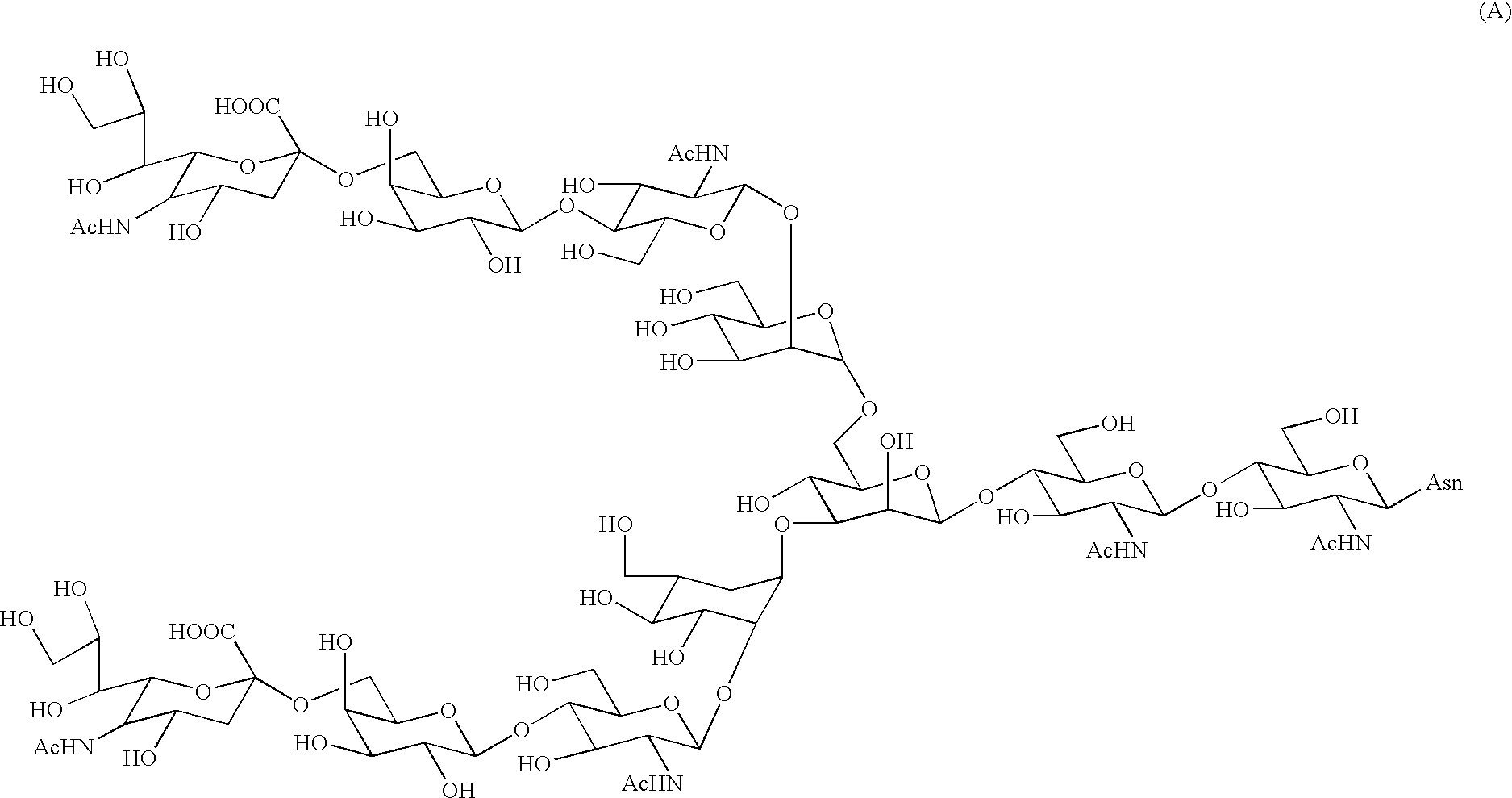Process for producing sugar peptide having asparagine sugar chain and the sugar peptide
- Summary
- Abstract
- Description
- Claims
- Application Information
AI Technical Summary
Benefits of technology
Problems solved by technology
Method used
Image
Examples
reference example 1
Preparation Of Asparagine-Linked Disialooligosaccharide (10)
[0132] A 500 mg quantity of roughly purified SGP (sialylglycopeptide) and 10 mg (319 μmols) of sodium azide were dissolved in 25 ml of tris-hydrochloric acid-calcium chloride buffer solution (0.05 mol / l of TRIZMA BASE, 0.01 mol / l of calcium chloride, pH=7.5). To the solution was added a solution of 50 mg of actinase E (protease, product of Kaken Seiyaku) in 5 ml of tris-hydrochloric acid-calcium chloride buffer solution, followed by standing at 37° C. The solution was freeze-dried 115 hours later. The residue was purified by gel filtration column chromatography twice, giving 252 mg of the desired product, i.e., Asparagine-linked disialooligosaccharide (10).
[0133]1H-NMR (30° C.) δ5.13 (s, 1H, Man4-H-1), 5.07(d, 1H, J=9.5 Hz, GlcNAc1-H-1), 4.95(s, 1H, Man4-H-1), 4.77(s, 1H, Man3-H-1), 4.61(d, 1H, J=7.6 Hz, GlcNAc2-H-1), 4.60(d, 2H, J=7.6 Hz, GlcNAc5, 5-H-1), 4.44(d, 2H, J=8.0 Hz, Gal6, 6-H-1), 4.25(bd, 1H, Man3-H-2), 4.20(...
reference example 2
Preparation of Asparagine-Linked Disialooligosaccharide (11) wherein Amino Group Nitrogen of Asparagine is Protected with Fmoc Group
[0134] An 80 mg quantity (0.034 mmol) of the asparagine-linked disialooligosaccharide obtained in Reference Example 1 was dissolved in a solution of 2.7 ml of distilled water and 4.1 ml of acetone, and to the solution were added 34.7 mg (0.103 mmol) of 9-fluorenylmethyl-N-succinimidyl carbonate (Fmoc-OSn) and 11.5 mg (0.137 mmol) of sodium hydrogencarbonate. The mixture was stirred at room temperature for 2 hours. After the completion of reaction was recognized by TLC, the resulting solution was concentrated in a vacuum to remove acetone. The residue was applied to a column (ODS column) filled with a silica gel having octadecylsilyl group attached thereto) for purification, affording 60.1 mg of the desired product, i.e., Fmoc-asparagine-linked disialooligosaccharide (11) in a yield of 68%.
[0135]1H-NMR (30° C.)
[0136] 8.01(2H, d, J=7.5 Hz, Fmoc), 7.80...
reference example 3
Preparation of Asparagine-Linked Disialooligosaccharide (12) wherein Amino Group Nitrogen of Asparagine is Protected with Fmoc Group, and Carboxyl Group of Sialic Acid is Protected with Benzyl Group
[0137] A cold aqueous solution of Fmoc-asparagine-linked bifurcated disialooligosaccharide (20 mg) was passed through a column [φ0.5 cm×5 cm] of Dowex-50 W×8(H+), and the eluate of aqueous solution was freeze-dried.
[0138] The Fmoc-asparagine-linked bifurcated disialooligosaccharide obtained was dissolved in cold water at 4° C., an aqueous solution of Cs2CO3 (2.5 mg / ml) was added to the solution to obtain an adjusted pH of 5 to 6, and the oligosaccharide solution was freeze-dried. The resulting sample of Fmoc-disialooligosaccharide was dissolved in dry DMF (1.3 ml), benzyl bromide (5.1 μl) was added to the solution, and the mixture was stirred at room temperature under an argon stream for 45 hours. After the completion of reaction was recognized by TLC, the reaction mixture was cooled to...
PUM
| Property | Measurement | Unit |
|---|---|---|
| Solubility (mass) | aaaaa | aaaaa |
Abstract
Description
Claims
Application Information
 Login to View More
Login to View More - R&D
- Intellectual Property
- Life Sciences
- Materials
- Tech Scout
- Unparalleled Data Quality
- Higher Quality Content
- 60% Fewer Hallucinations
Browse by: Latest US Patents, China's latest patents, Technical Efficacy Thesaurus, Application Domain, Technology Topic, Popular Technical Reports.
© 2025 PatSnap. All rights reserved.Legal|Privacy policy|Modern Slavery Act Transparency Statement|Sitemap|About US| Contact US: help@patsnap.com



